It’s been nine long years since Pumas last won a Mexican title. In that time ‘Los Pumas’ have had 11 new managers and zero trophies to show for it. When former Real Madrid man Míchel left, a few eyebrows were raised at the appointment of the inexperienced Andrés Lillini.
However, 10 games into the season, they have their best chance at a league title in years. With Liga MX’s playoff structure, Pumas haven’t been this close since they finished first in the 2015/16 season. However, losing out in the playoff final meant the wait had to continue. Los Pumas currently sit top of the league, without losing a game.
This data analysis will use data to examine how Pumas have put themselves in such a strong position. Statistics will be used in the analysis to compare Pumas to other Liga MX sides to evaluate where they are most dominant.
The system
Lillini has adopted a traditional 4-4-2 starting formation, where he aims to get his two wingers very close to the two strikers. The two strikers, usually Juan Ignacio Dinenno and Carlos González, play very narrow and allow their pacey wingers to get around them for support. Both have enjoyed lightning starts to the season, with Dinenno bagging six, whilst González has also scored four. As the wingers push on and almost create a front four, the full-backs then progress to create a flat four midfield. Lillini often chops and changes his full-backs, using four different pairings in the last five games.

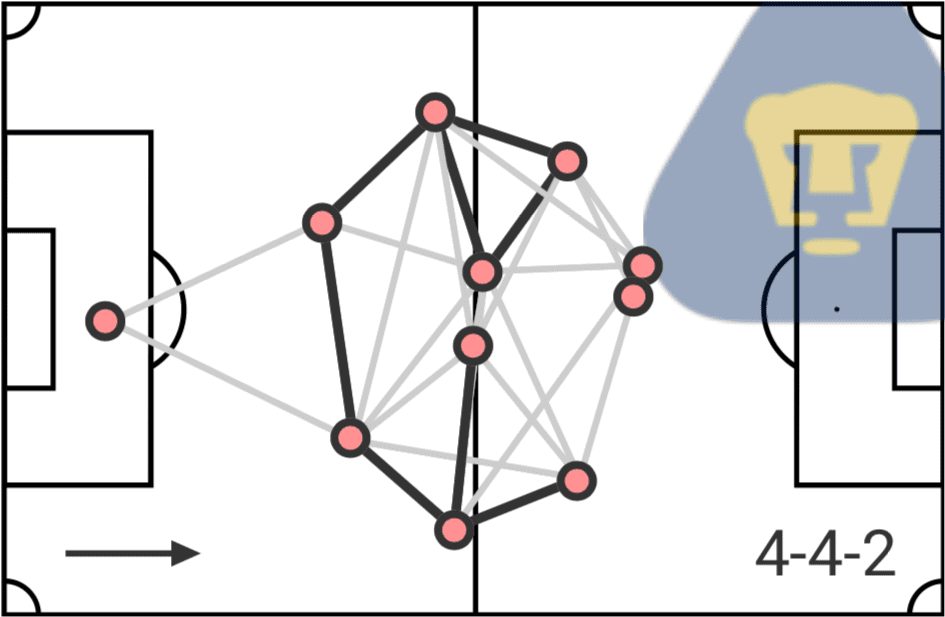
The pictures above show their most frequent starting eleven this season, along with their general shape and most frequent passing routes. Those with a darker line indicate a more frequent passing route. As mentioned earlier, we can see how narrow the two strikers are, almost playing on top of each other. The most noticeable feature here is the low number of passing routes into the two strikers. One would assume, that when playing two up front, a lot of play would go through here. However, Lillini has his men approach the game a lot differently. The analysis shows that the Pumas centre-backs often move the ball out wide to their full-backs, rather than progress the ball into the central midfielders.
With this, we also see that the full-backs, central midfielders, and wingers keep the ball amongst themselves until an opportunity in the final third presents itself. This 4-4-2 formation is Lillini’s preferred option, using it 64% of the time. In some games, Pumas have set up with a 4-1-4-1, albeit with limited success.
Keeping the opponent out
As mentioned earlier, Pumas are currently unbeaten this season. Whilst, they have won one fewer game than the two teams below them, they have made a real habit of not losing. In the 10 games they have drawn four, but ultimately aren’t losing. Very similar to Arsenal’s Premier League invincible season where they didn’t lose, but did draw 12 games in the process. Being hard to beat is a great trait to have.
Pumas’ fine form this season is largely dependent on their defensive stability. So far, they have only conceded eight goals, the fourth-best in the league. However, how they achieve this is slightly surprising. Firstly, we will use data to compare how Pumas’ defence compares to the rest.
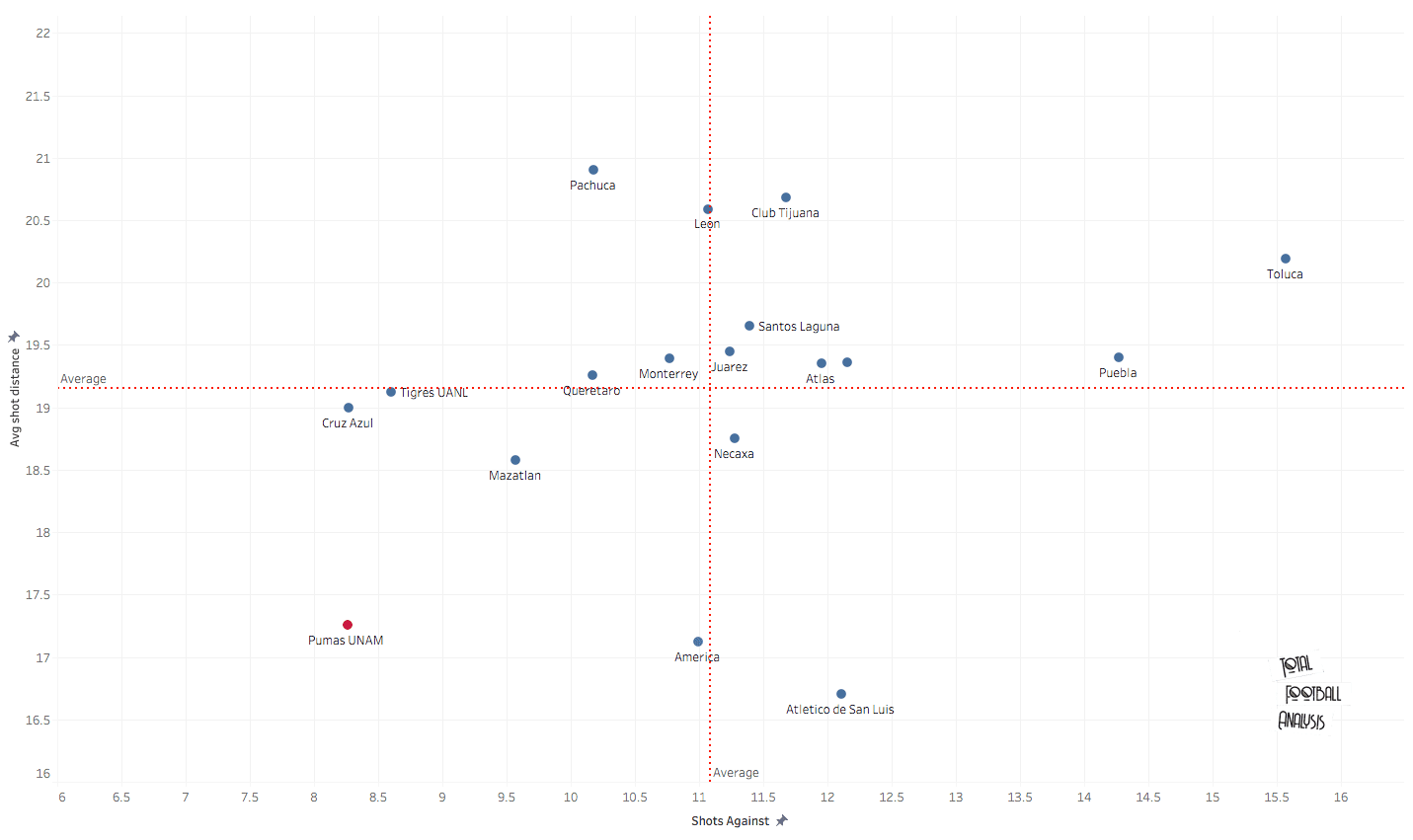
As we see above, the statistics show that Pumas face the fewest shots in Liga MX. Pumas face an average 8.26 shots per 90, far fewer than the league average of 11.08. This would suggest Pumas are very difficult to break down. Other title contenders such as Cruz Azul also face very few shots, with only 8.27 per 90. With Liga MX being so free-flowing and the number of goals scored each game, a solid defence could be the difference between a place in the playoffs.
An interesting aspect from the data above is the average shot distance from opponents. The Liga MX average sits at 19.15m, with a majority of teams sitting above this. However, Pumas have the lowest opponent shot distance this season, with 17.26m. Now, there isn’t much between this and other sides, however, it does ask some questions of Pumas. Could they possibly be easy to break through, or is it a tactic employed?
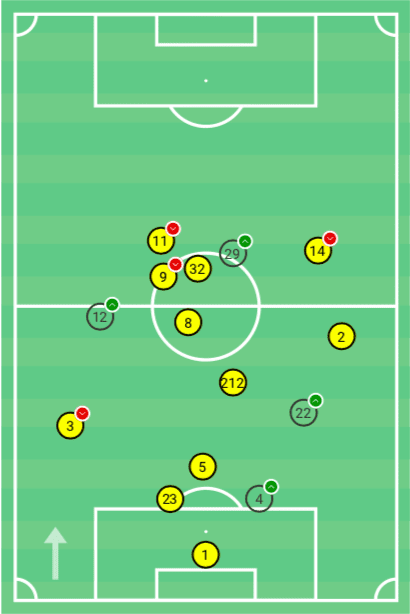
The tactical theory of the ‘low block’ is one that is usually frowned upon by managers and coaches. This theory occurs when a team is defending very deep, in the aim to limit the space for the attacking team. Whilst it has its positives of limiting space for the opposition, it can lead to ongoing attacks from the opponents. It is an approach often used by Atlético Madrid, who have shown that when used correctly, it can be extremely effective.
The picture above is an example from Pumas’ recent game with Santos Laguna, in which they won 2-1. This shape and formation would suggest Lillini is utilising a low block to starve his opposition of chances. Above we see how both central defenders remained on the edge of their own box for the majority of the game. It would also explain why Pumas have the lowest shot distance, however, they seem to be very accomplished in preventing these shots.
Ball possession
Liga MX is very fast-paced, and counterattacking is usually a key factor of most teams’ games. There are a few exceptions – for example, Tigres head coach has his own brand known as ‘Tuca Taka’ due to their possession-based approach. However, Pumas seem to be using neither of these.
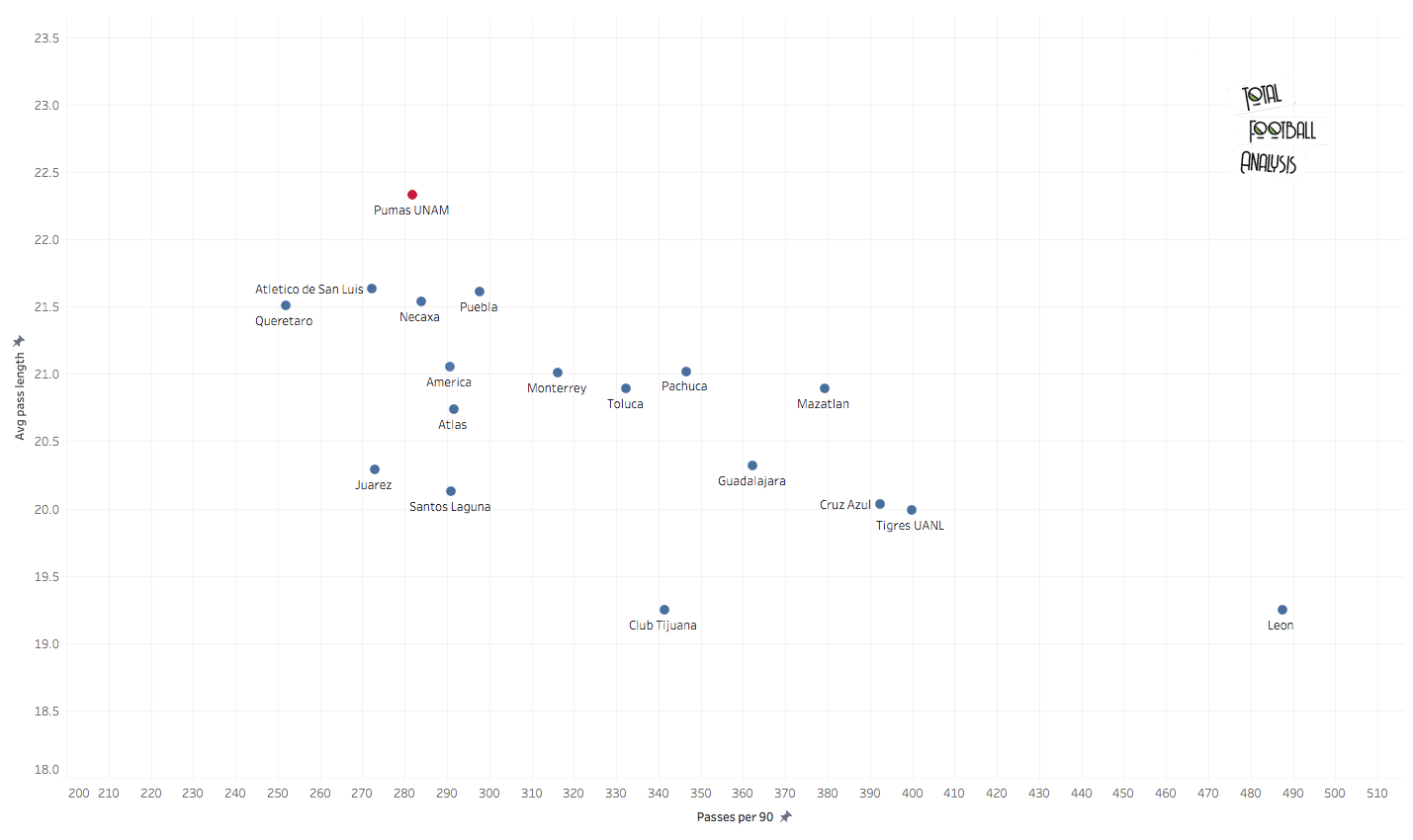
The statistics above show how little Pumas have the ball. Out of all teams in the league, Pumas average the fourth-fewest passes, with 281.8 per 90. This is extremely surprising, especially when we consider other top teams such as Cruz Azul. Cruz Azul average around 392.3 passes per 90, a staggering 100 more than Pumas.
It is not like Pumas combine their low block defensive approach with a counterattacking style, as they have only scored one goal from counter-attacks.
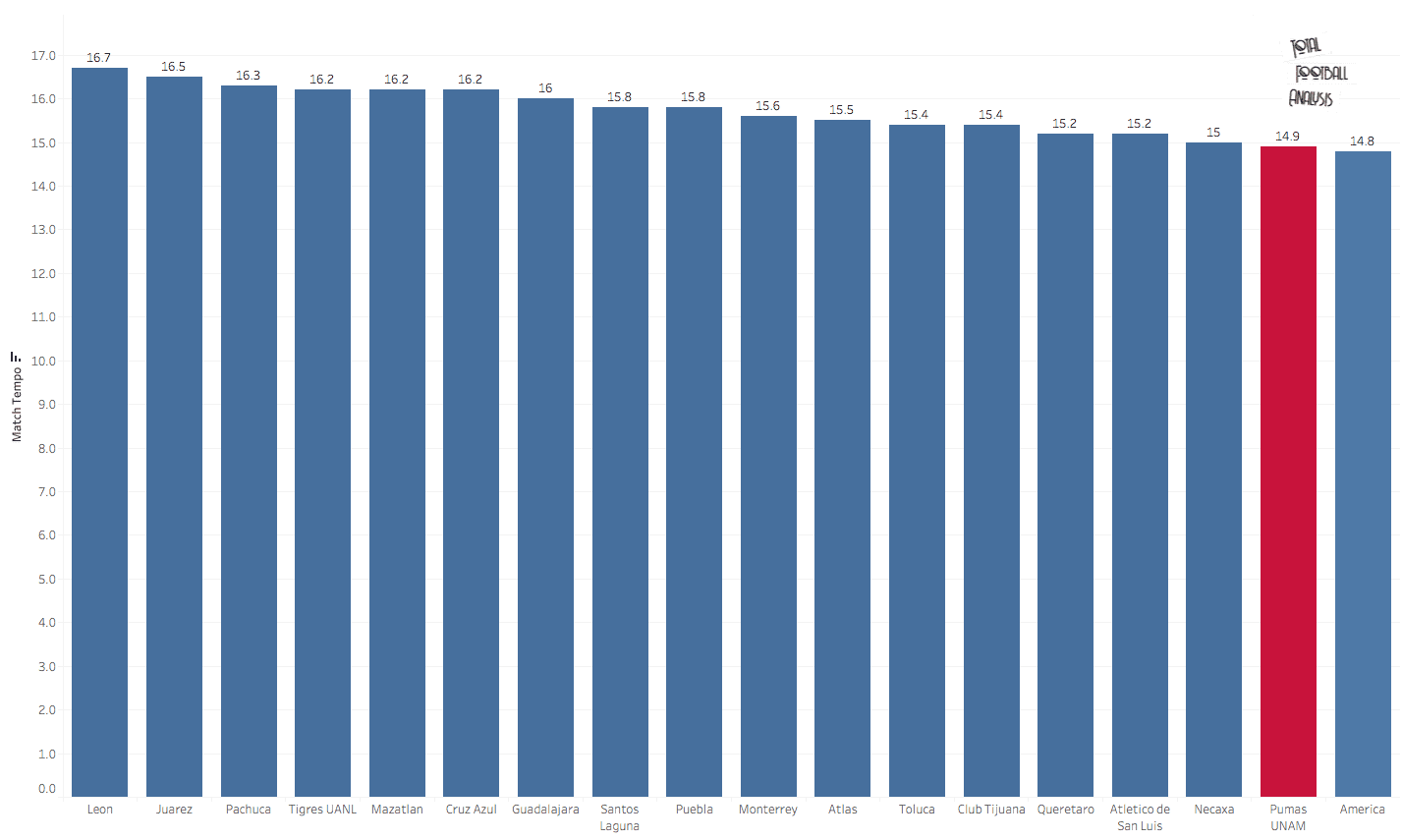
Pumas are also very slow in their build-up play. Match tempo is the number of passes played per possession. We can see from the data above, Pumas have the second-lowest match tempo with 14.9. To add to this, their possession only usually lasts 14 seconds, below the league average of 14.6 seconds.
The data above also shows they have the longest average pass length of 22.33m. This would suggest Pumas often look to go direct in their passing, as a way of progressing up the pitch.
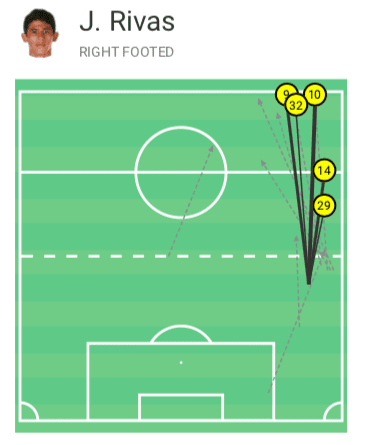
A snapshot of full-back Jesús Rivas’ passes provides more evidence to this. A high number of his passes are very direct, with plenty of them being over a long distance. A large majority of his passes are directed to the wingers or strikers, showing their preferred method of being direct.
Creating chances
The data analysis so far has highlighted how Pumas don’t keep the ball very well, and instead go direct when in possession. This was also shown above when we considered the type of passes defensive players made. This section will use statistics to see how Pumas break opponents down.
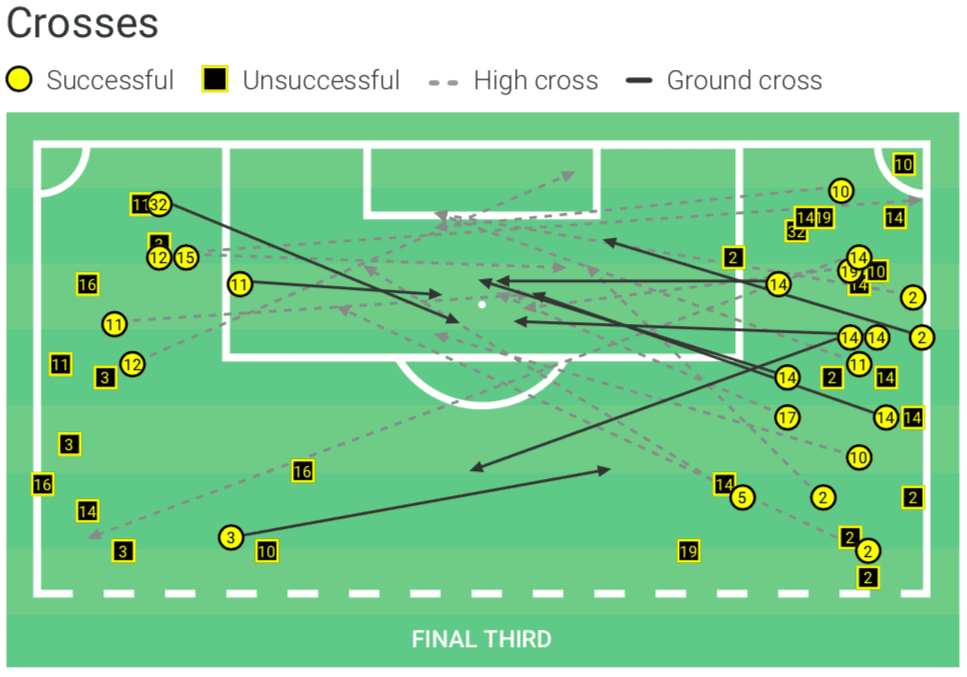
Crosses have been a key factor of Pumas’ approach this year. With a 4-4-2 formation, they usually have enough men in the box to utilise this. In the league, Pumas attempted the sixth-most crosses of all teams, completing 14.37 per 90. Earlier we looked at Pumas’ average positioning and saw the wingers were very high up the pitch. This would explain why their passing range is so direct, as they are trying to feed the balls into these areas. 47% of their crosses come from the right-hand side, as shown in the picture above.
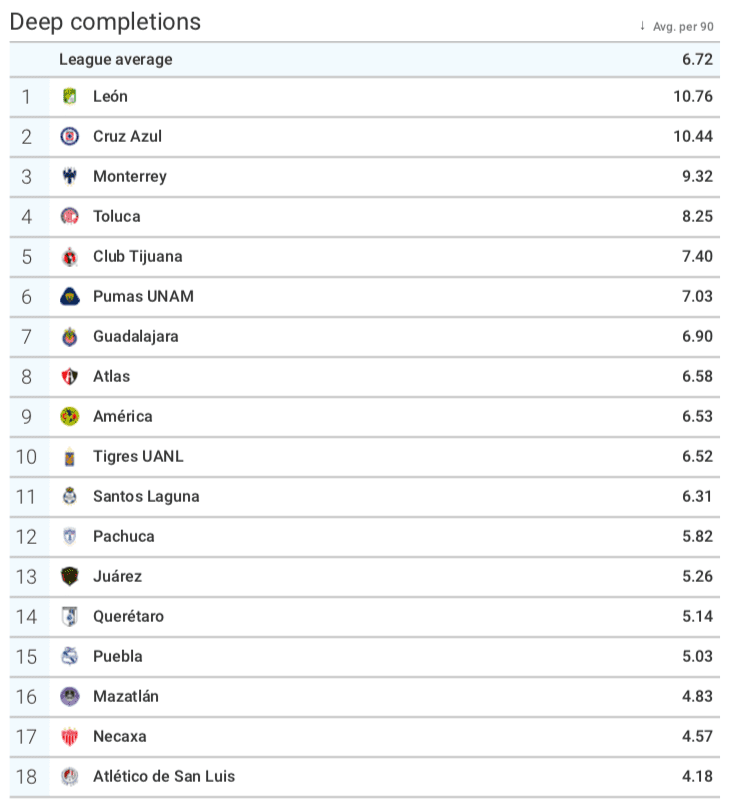
To add to this, Pumas also complete a high number of deep completions. They again had the sixth-most in the league with 7.03 per 90. Whilst Pumas may not be great at protecting the ball when they have it, they are eager to make it count. They have shown crossing is a key part of their approach, but also penetrating the defence from central areas is vital as well.
With two strikers on the pitch, Pumas have several opportunities to move the ball towards the box and do so well based on the data above. This, combined with their 13.66 touches in the opposition box, per 90, show that the Pumas strikers often have plenty of opportunities to pounce on.
Conclusion
Pumas could be on the verge of their first title in nine years, and this data analysis looked to examine how they put themselves in this position. The data showed that Pumas are very resolute in defence and look to limit the number of opportunities the opponent has on goal. Their use of a low block has been very effective.
Surprisingly, Pumas are not as efficient with the ball as many would think. They score very low in terms of possession-based statistics, and keeping the ball is certainly not a key aspect for them. They often look to go direct and get the balls into their strikers or wingers. This leads to several crosses being sent into the box for one of their strikers to latch on to.
Pumas are certainly going about their title-charge in a different way to other teams, however, it seems to be working. Lillini will be hoping his men can continue their form and look to avoid defeats until the end of the season.





Comments